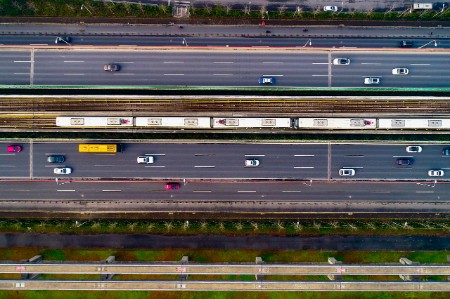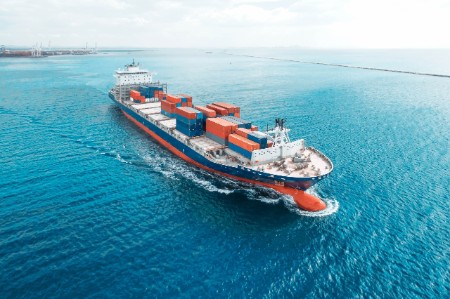
Chapter 1
Supply chain impact
CEOs, CFOs get interested in the flow of goods and services.
For a business world reliant on complex global supply chains, this ambiguity is being closely monitored. The World Trade Organization has warned that global trading volumes are predicted to fall from 4.7% last year, to 4.4% this year and 4% next year amid signs that “escalating trade tensions may already be affecting business confidence and investment decisions.” The International Monetary Fund, meanwhile, has reduced its estimate for world GDP growth to 3.7% from 3.9%, which is in part due to trade tensions.
As a result, the spotlight is now firmly on company trade directors, supply chain managers, regulatory and compliance officers, and tax accountants, as companies scramble to make sense of the situation.
Dalton Albrecht, EY Global Trade Leader in Canada, says, “The global trade function was often overlooked in a world where NAFTA provided duty free trade and the EU was in one bloc. There was no Brexit issue and no NAFTA/USMCA issue. There weren’t many duties being paid and even though there were customs compliance issues, people didn’t overly focus on them. But now, because there is more enforcement [of customs rules] and duties being paid, companies have to look at this.”
The situation is bringing the importance of supply chain management, and its associated functions, to the attention of the C-suite.
Related Article
We have seen a shift from operational mid-management, supply chain, logistics and trade director functions making routine decisions. Input is now coming from CEOs and CFOs wanting better visibility and a greater understanding of what the impact will be on the company. Also, they are being more proactive, trying to see what the alternatives are and how those might align with other strategies and initiatives such as moving into new markets.
Marc Bunch, EY UK Global Trade Leader, adds, “Since the summer of 2018, senior executives have been saying: ‘We can’t hold off any longer, we have to press ahead rather than wait to learn the outcome.’ While politicians can change tack from day-to-day business, bosses know that even the simplest thing such as changing the format of an invoice to comply with different regulations can take several months.”

Chapter 2
Creating your own certainty
‘Paradigm shift’ means trade disruptions are here to stay.
With trade disruptions looking as if they are here to stay, businesses are having to create their own certainties in an uncertain world. Albrecht says: “People are starting to realize that it is not temporary. It’s a paradigm shift – we are going to see constant trade disruptions.”
In a poll of 600 tax executives by EY in October 2018, 52% said that the US trade actions were having a “moderate” or “significant” effect on their business. A further 41% expected the situation to last for 6 to 12 months with 18% saying it will continue beyond two years. In addition, 20% said there was “too much uncertainty” to tell.
EY survey of tax executives, October 2018
52%of respondents felt US trade actions were having a "moderate" or "significant" effect on their businesses.
“The big challenge is knowing how long this trade war will go on,” says Yoichi Ohira, EY Japan Indirect Tax Leader. “It is political in nature, so will an election [the US midterm elections are in November 2018] change something in the next 6 to 12 months? If so, then companies might decide to ride it out, even if there is an additional 25% tariff. But if this is going to last three, five or potentially more years, then they really need to start deciding what they want to do with their manufacturing footprint now.”
Albrecht adds that “lots of people are stuck like deer in the headlights,” bewildered by the level of uncertainty and change. This is slowly changing, though, with executives across the world accepting that they need to act to keep goods and services moving, and act now, regardless of the machinations of politicians.
“How do companies prepare for something with an uncertain timeline and outcome?” asks Bunch. “The focus has to be on what you do know and what is highly certain as opposed to speculating on what you don’t know.”
James Mackie, Washington-based co-director of EY’s Quantitative Economics and Statistics group, encourages companies to work through different scenarios: “Any company impacted by recent tariffs as an importer or an exporter should model the impacts, as well as any potential expansion of the scope or escalation of the rate.”
How do companies prepare for something with an uncertain timeline and outcome? The focus has to be on what you do know and what is highly certain as opposed to speculating on what you don’t know.

Chapter 3
What to focus on
Preparing for Brexit, and how to keep goods moving.
The focus for companies preparing for Brexit is concentrated on three things:
- Regulatory: What licenses do we have? Will they be operable after Brexit?
- Supply chain: How can we prepare for a hard border and the customs declarations that will be required?
- People: Are our people being looked after?
Bunch says: “The focus isn’t necessarily on cost management and tariffs: it’s on how to keep goods moving.”
Preparation involves some very practical issues. The UK port of Felixstowe, which employs many customs officials and is used to dealing with goods from outside the EU, might be better able to scale up to deal with a hard border than the busier Dover, for example, which almost exclusively handles EU traffic and has few customs officials.
Related Article
On both sides of the US/Canada border, attention has until now been focused on mitigating the effects of the tariffs. This includes looking at whether duty values can be reduced, considering options for duty deferral such as using free trade zones or bonded warehouses, and looking to whether companies can reclaim any of the duty paid, explains Leightman. Although exemptions cannot be relied upon, while the US has approved 55% of requests from the steel and aluminum industry for a one-year exemption, only 10% of the requests for exemptions from the China tariffs have been approved.
US Department of Commerce, July 2018
55%of requests from the steel and aluminum industry for a one-year tariff exemption have been approved.

Chapter 4
Tariff classification becomes more urgent
It may be time to relocate parts of your business.
Albrecht says: “Another thing we can do is look at tariff classification. Nobody really paid attention to tariff classification before, but it is important to get it right when you have various tariffs on specific goods. You could argue it wasn’t as significant when it was all duty-free, but now you have to be specific because it is the difference between a 25% surcharge or nothing.”
In the long term, the focus needs to widen and serious consideration given to relocating parts of the business. Armando F. Beteta, leader of the EY Global Trade services at the Latin American Business Center, says: “What we have seen recently with the Brexit uncertainty is that a couple of clients are planning to move manufacturing or assembly to another country. For example, if they are currently exporting from the UK to Latin America, they are now considering Mexico as an alternative.”
Leightman adds: “We are involved in helping clients evaluate a wide range of scenarios and looking at whether they have the flexibility to move to manufacturers in other locations where the impact may not be as deep or will be more predictable. We are also helping to evaluate movement in their own global footprint in a way that might mitigate the impact of tariffs, even if there is an incremental cost increase to operations.”
He gives the example of an electronics manufacturer that supplies the US from China and so incurs tariffs. It has a plant in Mexico that supplies the Latin American market but is not yet able to supply the US. It also has a European factory that supplies the European market. A new solution is to shift production so that the European plant supplies the US, and China supplies Europe, while the operation in Mexico is upgraded with the long-term objective of supplying the US.
“It will likely be less efficient and also potentially cost more from an operations perspective but it is cheaper than incurring the US tariffs on the Chinese goods. So there is a lot of scenario-planning, which then starts to overlap into how the company might be set up from an international tax perspective, as well as looking for other opportunities,” Leightman explains.

Chapter 5
Finding solutions is a global puzzle
Find strategic value in operational and functional changes.
The same process of mapping supply chains and looking at options is also taking place on the other side of the Pacific. “There is a lot of uncertainty about what will happen next and the concerns of companies vary as does their ability to respond,” says Bryan Tang, EY Global Trade Leader for China.
The high-tech can be nimble but not everyone has that ability. If a component is made in the US but the demand is in China, then that imposes limitations on companies trying to find solutions.
It takes time to analyze options and move operations and, as an interim measure, some businesses are looking to set up trading companies – a Canadian sales office in the US, or a British subsidiary in Germany, for example.
It is clear that businesses are no longer waiting on politicians: they are creating their own certainty. “Businesses can’t rely on politics,” Bunch says.
We will start to see ports get busier because industries that can build inventory, will build inventory. That means they are going to import more from the EU so that there is less stress at the ports if we have a customs border. Whatever the politicians decide, we will see ports getting very busy with ships full of containers, even as early as January 2019.
Although companies have been forced into action, the changes that they make now could benefit them for years to come with a renewed focus on supply chains, which has thrown those working in what was once a back-office function into the heart of business strategy.
Leightman says: “This has helped C-suite executives realize that what has been operational or functionary might actually have some strategic value. We are now starting to see companies embrace how to be more proactive. We are seeing them look at how they can use some of these trade strategy and planning ideas that have been out there for many years but have somehow become marginalized. Now, because of the cost impacts of the tariffs and other trade disruptions, they’re realizing that they have to do this now to stay nimble and competitive.”

Chapter 6
Key action points
Four things you can do today.
- Undertake a full assessment based on what you know. Look at tariff classifications and the origin of component documents closely. Develop a comprehensive strategy on duty mitigation or deferral that might help you handle the impacts of duty changes right now while you work on the long-term strategy.
- Map out all your supply chains on an end-to-end basis. Don’t just look at what you directly control but also look at where everything starts and ends. You need to understand where the exposure is and the only way you can do that is to map out all the different supply chains; don’t just focus on the big ones because it is more likely to be the smaller ones that cause problems.
- Think diversely around the impacts to your business. Bunch explains: “Let’s say you are a manufacturer of goods in the UK and you use quite a rare chemical to clean the machine in your factory that allows you to produce things. This is about understanding where that chemical comes from and where its supply might be disrupted.”
- Don’t just think about the trade component of the operation but include other corporate functions: tax, finance, legal, HR, regulatory and compliance. As Leightman says: “Across the globe we are seeing an increase in inspections and requests for data and information on declarations, so we are recommending that regulatory and compliance are involved.”
Summary
Thanks to a level of complexity not seen for many years, multinational companies face a new debate about how to do business across borders. Finding solutions will be imperative – companies will need to work through different scenarios and model the impacts if they are to thrive in this new environment.


